#and i grew up in a malayali family
Text

this is just based off my observation btw
#there are so many tiktoks of irish people not wanting to leave ireland but they have to because it's too expensive to live there#and i grew up in a malayali family#let me tell you#there is no longing like a malayali that wants to go back to kerala#i've never seen my parents more comfortable than when they're in india#my dad is actively miserable here#so i figured it's the same for the irish#the 'i don't want to leave but i can't live here'#introspective.txt#the irish#kerala#malayali
0 notes
Text
I am going mad . . .
When I read Ponniyin Selvan, I imagined Aditha Karikalan to look like this but with expensive clothes and gold jewellery.

This is a still from the 1991 Malayalam movie Perumthachan. He 👆🏽played Kannan, the son of Raman Perumthachan who was probably the Chief Architect of Tanjai Temple. The master carpenter (Perumthachan) is a legendary figure in Kerala and many temples and other structures are attributed to him.
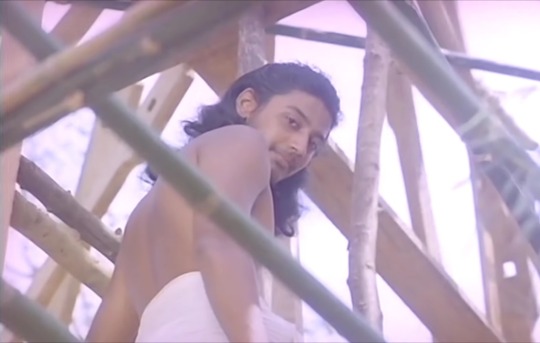

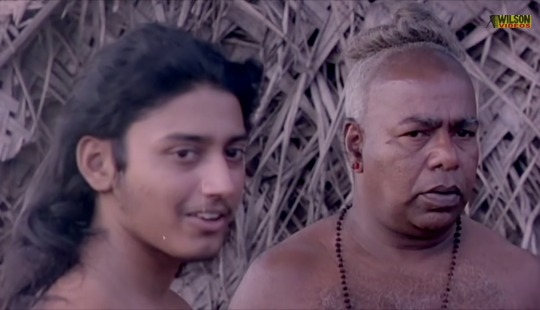
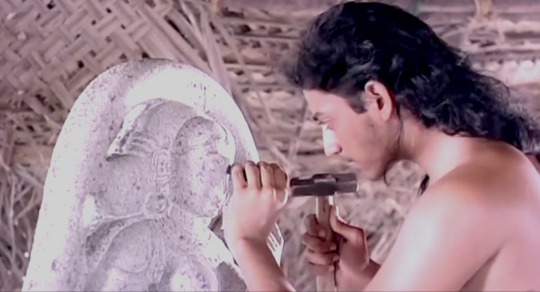
See, we Malayalis always had trendy hairstyles.
Kannan is a great craftsman and a rebel who questions the existing norms and social hierarchy. He is also involved in an intercaste, inter class love affair to the disapproval of all families.




Reverse Nandini-Karikalan situation as he is a carpenter and she is nobility.
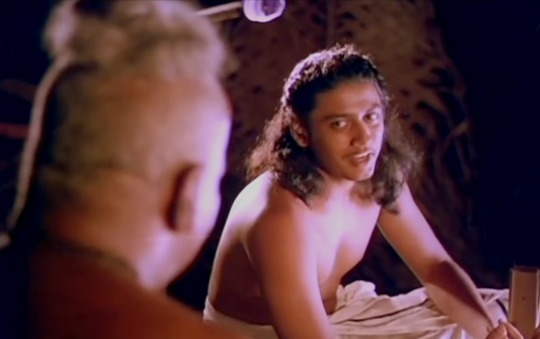
I am a kid, but I am going to lecture you.

I am sexy and I know it.

I am feeling feelings and I don't know what to do with them.

I am a lost cause.
Isn't Kunjikkavu stunning?
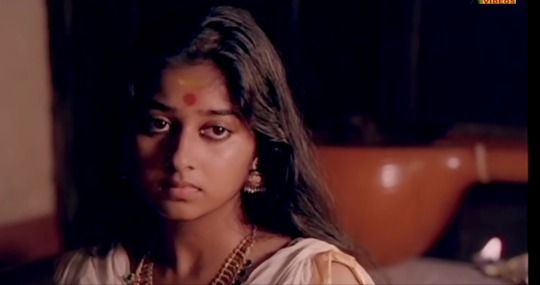


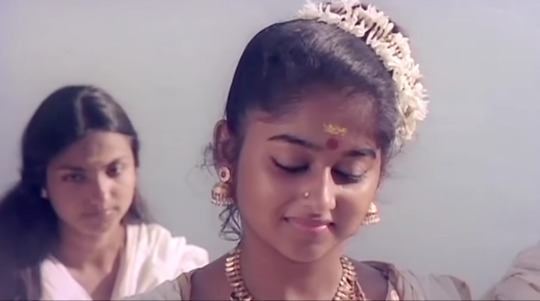
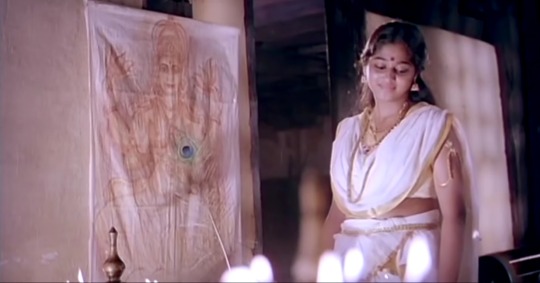


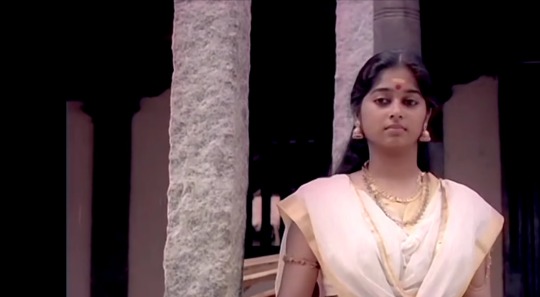
Kannan's muse and ladylove, Kunjikkavu Thampuratti (Princess) 😍 She was played by Monisha Unni who passed away in 1992. She won the National Award when she was just 16.
But you know what? I always thought that this actor is Sanjay Mitra, who played Rishyashringan in another Malayalam movie.
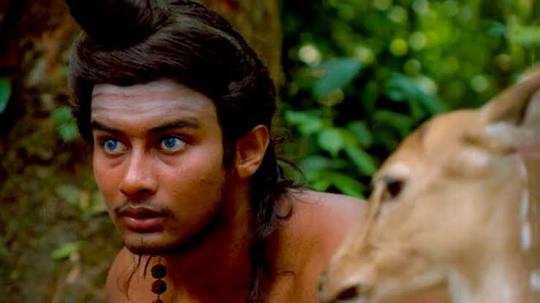
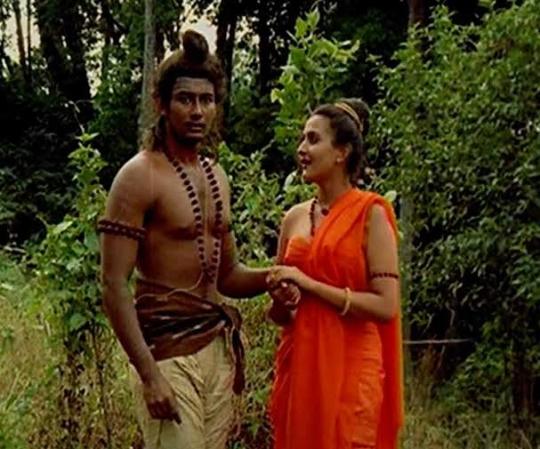
I know I am dumb, but you really can't blame me. These guys share the same moodboard.
But yesterday I realised that I was wrong. How the hell could this happen? This is Prashanth!!!
youtube
Prashanth was the first Tamil superstar from the 90s. Perumthachan was his second movie and he was just 17 years old in it. 'Top Star' Prashanth grew up into a young man and always had a very suave urban look in his Tamil films. That's why I couldn't recognise him. Unfortunately, his career fizzled out due to some career missteps and the rise of Vijay and Ajith.
youtube
And the most funny thing about this is that Prashanth is the cousin of Vikram who ended up playing Aditha Karikalan.
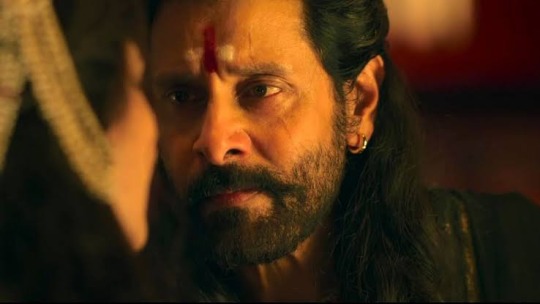
I am not joking. Prashanth's father Thiagarajan and Vikram's mother Rajeshwari are siblings. The families aren't on talking terms for some reason. I heard that it is because Rajeshwari had an inter-religious marriage without their permission. Meanwhile, Prashanth had to get his marriage annulled because that lady was married to another man all along.
😮
Was this role always meant to go to someone in this family? Prashanth too was a Mani Ratnam hero, way back in 1993 (Thiruda Thiruda).


Now I want to check Santosh's family tree and see if he is related to them in any manner.
My sense of reality is shattered. It might take some time to recover from this. How do I deal with this?
@willkatfanfromasia @celestesinsight @ambidextrousarcher
#ponniyin selvan 2#ponniyin selvan#aditha karikalan#nandini x aditha#nandini x karikalan#nandini#nandhini#nanditha#chiyaan vikram#vikram
40 notes
·
View notes
Text
11+11=22 Questions
I got tagged in two of the 11 questions ask games by @elnas-studies and @hardlyfluent (thank you both so much!!), so I combined them both in a really long hell post which I’m putting under a cut because otherwise this will be horrifying
RULES: Answer the 11 questions. Make 11 of your own and tag 11 people.
1. how old were you when you started learning other languages besides your native one(s)?
Unless you count my early attempts to learn Malayalam, which arguably started at the age of about two, then I’d say I really started learning another language when I had to take Spanish in sixth grade, which was a struggle at first but eventually I fell in love with it
2. have you ever dated one of your crushes before?
dating???? crushes????? im donot know what youre talking about
3. what is your strengths and weaknesses as a language learner?
My strength is probably my refusal to think things are “weird” or “difficult” and just kind of accepting them as a fact, and also the fact that I adore grammar. My weakness is definitely that I loathe learning vocabulary, and also the fact that I tend to just skim stuff to learn all the cool grammar and never actually practice anything :,))
4. why are you studying the languages you are studying?
oh boy get ready this is going to be a long ride
Spanish - I had to take it in school but the reason I currently speak it to any degree is probably thanks to my obsession with Latin pop during the dark years of my life (we don’t talk about that here)
Catalan - because it’s perfect and also because I love literally every aspect of Catalan culture, did you honestly expect me to say something else??
Welsh - originally because I read a series called The Dark is Rising when I was in fourth grade and it had Welsh in it and I was like I want to learn this and so I (sort of) did
Basque - not gonna lie, this one was for Xabi Solano (if I try to pretend like it’s not y’all will find me out eventually because everything is on this blog)
Turkish - good question, why am I learning Turkish?? jk, I think Turkey is a fascinating country with a really interesting history, also it appreciates cats so that’s a win
Western Abenaki - this is an indigenous language from around where I’m from so I feel like the least I could do would be to learn it considering I’m occupying their land, also I grew up listening to an Abenaki storyteller named Joseph Bruchac so it’s close to my heart
Romani - this was also a language I wanted to learn in fourth grade because we had an album of Romani music and it was one of my favorite things in the world and I wanted to be able to learn all the words to the songs, I guess not much has changed since then
Malayalam - me?? learning languages for actual reasons??? it’s more likely than you think (this is my heritage language, my dad’s family is Malayali)
Arabic - originally I had good reasons for learning this, now I’m just doing it for Mashrou’ Leila
Tamahaq - in case you’re not seeing a pattern here hopefully this will help, I’m learning this for Tinariwen so I can understand their songs
5. where in the world would u move to if u could?
Either the rural Pyrenees somewhere (La Garrotxa or Ripollès probably), somewhere in the New England woods, or Minneapolis (sorry I just really fell in love with that city it’s not my fault that it’s so good)
6. what is your favourite food in ur target language(s)?
pasta, I think it’s the same in probably all of them except Turkish, which is makarna
7. what is your favourite genre of books and/or movies?
I used to be a big sci-fi and fantasy person (and still am to some degree), but now I also really like historical fiction (although still with a dose of fantasy if it’s done well), plus literally anything gay
8. do you like poetry? if so, who is your favourite poet?
I’ve never really been into poetry but I absolutely adore Vicent Andrés Estellés
9. have you ever studied abroad?
Not with school, although I did study Spanish at a language school in Oaxaca for a week one summer, but I’m hoping to go to Senegal to do my Official College Study Abroad™ and learn some Wolof :))))
10. what is ur biggest fear?
I have a lot of these, do you really want to get into that (probably either dying or the depths of the ocean)
11. what is the one thing u can’t live without?
Probably my computer because I’m Trash™
1. If you could change your name, would you? and to what?
I actually am seriously considering changing my name irl, but I do also really like my birth name so I’m not sure, this is a difficult question
2. Do you have a favourite artistic movement?
I’m not a cultured person who is capable of having that sort of opinion, although I’m a big fan of art romànic in Catalunya, which is sort of a weird thing to be a fan of but that’s how it be sometimes
3. If you could move anywhere in the world, where would you go?
moving temporarily?? either somewhere in Catalunya or my family’s house in Kerala because it’s going to get sold soon probably since no one lives there anymore but it’s really important in my family’s history and I want to experience it before it’s gone; or, on a less serious note, a sheep farm would also be very nice
4. Do you collect anything? If so, what?
This is going to sound weird especially because I did this as a nine-year-old, but I used to collect business cards?? Now I just collect plants. Lots of plants. Too many plants, really, but who’s to stop me?
5. What is one piece of media that you think everyone should watch/read?
idk if this counts but please watch the video for “Roman” by Mashrou’ Leila, it’s amazing (I could rec books and stuff but I don’t have the same taste as people and also a lot of the stuff I watch/read is either trash or too mainstream to bother putting here)
6. What was your first favourite band/singer?
Hmm…let’s play it safe and say the Academy of St. Martin in the Fields because I was a cultured 4-year-old who listened exclusively to classical music (what happened to me, we will never know), outside of that I’m honestly not sure because I’ve had favorite bands my whole life and so it’s hard to say who was the first
7. What is your favourite season?
Autumn, but honestly my favorite season is whatever season comes next, I’m always ready for the change when it (finally) happens - that’s why I can’t live in places where it’s warm/temperate all year round, I’d go crazy
8. What’s your favourite song from your home country?
Oh wow this is difficult because (1) there’s a lot of music from the US and (2) I listen to almost none of it so... I’m going to pass on this for now
9. Is there any fashion style from the past that you would like to bring back?
I’m the wrong person to ask about fashion, I have the fashion sense of one of those guys on Queer Eye who Tan has to save because they wear jeans and a t-shirt to everything
10. What song do you currently listen to the most?
I’ve been listening to “Imm El Jacket” a lot recently because it’s the best, also “Entre poetas y presos” by La Raíz
Here are my questions:
1. What was your favorite childhood book/series?
2. What’s your favorite song in each of the languages you’re learning?
3. Do you prefer living in warm weather (above 25ºC/75ºF) or cold weather (below 0ºC/32ºF)?
4. Do you have pets? What kind/what are their names? If not, would you like a pet?
5. What is piece of advice you would give to your younger self if you could?
6. Who is one famous person that you really like/look up to?
7. What is one thing that you like to do that no one would expect of you? (as in something surprising/something that doesn’t fit with your personality or other interests)
8. Would you rather live in the woods or in the city?
9. What’s one thing in your daily routine that always goes wrong or always irritates you?
10. Do you still have your favorite childhood toy/stuffed animal? What is it?
11. What’s one thing that motivates you or keeps you going when you’re having a hard time?
I’m going to tag @incelphobiia, @reyneclaw, @euryalus, @chatwiththeclouds, @elphaba-masala, @bouzhi, @deepsearuin, but don’t feel obligated to do this at all, it’s totally fine if you don’t want to ^^
#thank you for tagging these are always really fun#sorry to take so long to do this#random stuff#tag games
6 notes
·
View notes
Text
Blog Overview
Hello all! You can just call me Saado. Here are a few things about me, my practices, and some other things:
Religion: 85% Indian Episcopalian/15% Malankara Orthodoxy (closer in orientation to Protestantism, with some Catholic elements) - because of the historical cultural legacy of Indian Episcopalianism’s heavy borrowing from Syriac Orthodox Christians, there are also unavoidable Oriental Orthodox elements to my religious practice.
Practices: (1) Sunday Church (not as much recently as there are no Indian Episcopalian Churches where I live now), (2) reciting The Lord’s Prayer twice a day in a private dark room, (3) charitable work and donation (I will keep the details undisclosed for obvious religious reasons). I generally keep my religious and secular lives separate, and the earlier mostly private/secretive. I discuss religion only when absolutely appropriate in a given social context.
Familiar Religious Texts (in order of familiarity): (1) Bible (both KJV and Peshitta), (2) Bhagavad Gita, (3) Dhammapada, (4) the Tirukkural, (5) the Dao de jing, (6) the first half of the Quran (still reading through it - it’s a fairly dense book!), (7) the Mulamadhyamakakarika, and (8) the Arthashastra
Future Texts of Interest: (1) The Catechism, (2) the Guru Granth Sahib, (3) the Vedas, (4) the Agamas. I’m of course open to suggestions for future texts to read.
Myself: I am a South Indian-American Episcopalian, 25 years old, and male. I am an Economics PhD student IRL. In my free time I enjoy reading about religion, culture, weather, geography, and history as well as working out. I grew up in a religiously diverse+mixed household and state (New Jersey) as a Christian with some practices viewed by Westerners and even some Hindus as being exclusively Hindu (e.g. Pongal, Bharatnatyam, etc.). For the sake of my privacy (and to keep my blog off the eyes of prying colleagues), that is all I will reveal about myself.
My Family: Though I am Christian, my family is religiously mixed. My mom’s side is mixed Tamil Christian and Kannada Muslim (mostly Sunni but also a few Twelver Shi’ites), while my dad’s side is very diverse; his dad was also Christian, but his mom was a Burmese Buddhist (who converted to Tibetan Buddhism late in her life). Most of my uncles and aunts on my Dad’s side are Christian, but some are Hindu and one is Jewish. His side is also ethnically very diverse (Indian Tamil, Sri Lankan Tamil, Malay Tamil, Malayali, Burmese, and Mizrahi Jew). All of these ethnic and religious differences are united under the context of largely Hindu Tamil household and clan culture (including patronage of our traditional clan deity, which is also the namesake of my IRL surname).
Myself Compared to my Coreligionists: Compared to the average Indian Episcopalian, I would say my theological are almost identical to that espoused in Episcopalian doctrine. My views are different mainly in the (1) conception of who/what God is, and (2) the validity of directing worship to Jesus. To keep it short and simple, for (1) I view God as being separate and not co-terminus with creation (many Indian Episcopalians hold a pseudo-Hindu view to the contrary which seems unfounded in both scripture and empirical observation), and who is quasi-personal. For (2) there is no strong textual evidence that one can worship God through Jesus in any of the four Gospels. Jesus tolerated worship of God through him, but did not uphold it as the ideal form of worship much less worship of himself only. Though faith that God has saved humanity through Jesus is crucial, Jesus is also part Man; hence worship of Jesus risks worship of the non-Divine aspect of Jesus. To sidestep the possibility of sin, worship should ideally be directed to God alone, or refer to Jesus only through his importance of connecting humankind to God (many Episcopalian Hymns do just this, but modern Christian music and psuedo-Christian movements (e.g. evangelicals, pentecostals) seem to be awry to this fact).
Who can follow: My blog is open to everyone to follow (I really mean everyone)! I am generally open and accepting of other religious orientations. My only prerequisite is that you if you interact with me, you do so on good faith, and I will do my best to do the same. If I’ve said something ignorant, please do not hesitate to notify me. I am still learning.
0 notes
Text
Bangalore days - Nanna Life in Namma Bengaluru
If you hear the word Bangalore, which Malayali would say no?
~ Kuttan (Nivin Pauly's character from the movie Bangalore days)
That was the case for me too but life had become stressful when I moved from Mumbai to Bengaluru a year back. My parents settled in Trivandrum, I was juggling between 3 cities. Three operations and a dialysis back to back, my move was a blessing because I could reach my parents faster anytime at a cheaper cost. However, the strain associated with it was good enough to take a toll of my mental health. I was missing Mumbai and all the struggles associated with moving to a new city were clearly affecting me.
Work was equally demanding and even though I had a supportive team, I was always having a sense of not being able to give enough. Soon, I started becoming toxic to everything around me. Nothing made sense and I would get irritated at the drop of a hat. Loneliness started creeping in and it just felt like the odds are not in my favor. If only someone could understand me.
That's when I came across this quote.
Have 3 jobs in life – one that gives you salary, one that keeps you fit and one that gets you creative.
~ Unknown source
What excited me reading it, I don't know. Probably the possibility of donning multifarious hats awoke my Mumbaikar spirit. Suddenly, I could feel the buzz and the energy in my bones and I started looking forward to it.
To start with - Salary, well, I already had the job. What should I do to keep fit?
That's when another quote struck!
When you want something badly, the whole universe conspires to make it happen.
~ Pauolo Coehlo (The Alchemist)
Salsa, Bachata, Jive – as if the ballet dancer in the picture of Dance with me studio was staring at me. I used to see it everyday while commuting to office, but how come I never payed attention to it?! So, dance it is! Fitness – check it off!
Next- Creativity
Again, Paulo Coehlo's words started ringing in my ears. I had always wanted to learn art. Cool, that's settled then! Enroll for art classes and burst your creativity!
Now, a 9 hour job and Bengaluru traffic don't go hand in hand. I had to find a way where I could have the cake and eat it too!
Soon, a time table was set considering the commute time and the space for intermittent relaxation periods. Because self care, while necessary, shouldn't become exhausting by overdoing it out of excitement of newfound strength and invincibility! You can conquer the world but hey! hey! take one day at a time!
I realized weekdays I was out for work anyway. So, enrolling for classes on such days would be a good idea because that would ensure I attended them no matter how much ever tiring they seem because the traffic here would discourage you to step out of the house on weekends. I decided the weekends could be a leisurely one instead.
Hence, I chose the less peak hours of 12 to 9 pm shift which fortunately my project had. Twice a week, I would attend dance classes in the mornings and freshen up in the office shower rooms and login to work. Surprisingly, even though initially, it was hectic, dance brought out joy in me. I would feel rejuvenated and work was becoming pleasurable. My face started to glow, I would joke with my colleagues, call my parents regularly. There was more laughter and happiness around. The remaining 3 days I would do simple yoga in the meditation room in the office premise. I also made it a point to spend half hour in the library known as the Information Resource Center (IRC). Reading edit page in Bangalore mirror became a ritual and attending video screenings arranged by IRC became part of the work DNA. It motivated me to work better and build effective relationships at work.
I enrolled for art workshops during weekends and would spend an average of 3 hours of learning. Here, there was no pressure of commitment because it would be a one time activity and one could take our art work the same day. Soon, I ended up making macrames, dot mandalas, paintings using fluid water colors, acrylics and pallete knives. A finished art work would make me feel proud and the weekday stresses melted away in the art. The remaining hours went in cleaning my room, washing clothes, watching movies, go for shopping etc.
The new found love for myself, made me even bolder now. I realized, I had always wanted to teach music. And lo! the opportunity came in and I got 3 kids between 5 to 16 years of age under my tutelage! I was now an entrepreneur!
It was here Maya Angelou's words came to my rescue-
If you get, give. If you learn, teach.
I realized only when you give back to the society, your life becomes meaningful. And volunteering is a great way to start here. What better than TATA initiatives? I began teaching spoken English to security and house keeping staff once a week on weekdays. Though my joy grew multi fold, so did my work obligations. Volunteering on weekdays gradually became a distant possibility. But I was not to give up. When plan A doesn't work, there's always a plan B and the remaining 24 English alphabets! I decided to contribute through content creation instead of teaching and shifted volunteering to weekends instead of weekdays. This resulted in getting associated with other volunteering activities such as making doodles for road safety or attend awareness sessions on mental health or environment conservation or read stories to kids in a children's home.
It is said that charity begins at home. For me, it began with myself. The moment I started to take care of myself, it got extended to my family and friends, colleagues and relatives, work place and communities.
It was now time to give back to the city that embraced me with open arms. Through The Ugly Indian suggested by a dear friend, I contributed to this NGO's efforts to beautify Bengaluru by adopting the streets, flyovers, underpasses, metro stations, parks through simple geometrical wall paintings, garbage cleaning and sapling plantation, all of them famously known as spot fixing.
I realized my problems were indeed manageable. And slowly my cribs turned into love. The expectations from myself, my family, work, colleagues, friends, relatives, communities became easier to maneuver. I started maintaining Gratitude and Thought journals. It is said that either you do what you like or like what you do. I know I have the capacity to look for things I want and pursue them. How about trying the other way round? i.e. instead of going for what I want, can I go for what is available? What does the city offer? Do I like it? Do I want to experiment with it? The answer was a big YES!
Famous for numerous start ups, the city is active with events such as dialogues with books, travel, cinema, board games, comedy nights, karaokes in various cafes or at cubbon park and with film screenings and theater performances in metro station auditoriums too! People are ready to welcome new ideas and experiment with them. Boasting of cycling enthusiasts too, I also went for one day cycling trips. The Indian Heritage Walks (IHW) helped me see the city through a different lens. Karnataka being a state blessed with forests, beaches and heritage sites, weekend getaways are pretty popular in the city and I managed to visit Hampi (a long time wish, thanks to the Malayalam movie Aanandam) and Coorg through an adventure group and Karnataka State Tourism Development Corporation (KSTDC) respectively. My next in the wish list is Jungle lodges!
As Bengaluru traffic is unavoidable and since I travel by AC Volvo buses of Bengaluru Metropolitan Transport Corporation (BMTC), I decided to read a book during the commute to not only avoid the boredom but to also add variety to my creative pursuits.
Known also for pub culture, I reconnected with my cousins already settled here, and together, we explored pubs, fine dine restaurants, reminisced the old days, shared laughter, played poker, watched cricket matches and had loads of fun in simple terms!
From all this I realized, when you know and accept who you are and then go for what you want, what you think, say and do, come in perfect harmony. You end up loving more, giving more and caring more. Genuinely.
At the risk of sounding cliched, life is indeed a balance. It is simple but we make it complicated. That reminded me of a joke shared by a psychiatrist in the TV show Satyamev Jayate -
Agar 100 saal ki zindagi, 10 saal mein jeena chahoge, toh pareshan hi rahoge na?
(If you aim to live a 100 year life in 10 years, wouldn't you be stressed?)
Now I give percentage of importance to all that matters to me. I neither chuck out anything or compromise anywhere. Because I know I can have it all but not all at once. I remind this kindly to myself and just play with the levels of significance. I try to be flexible enough to change them when necessary. I also try to embrace negative emotions like disappointments, anger, frustration and later change the way I feel about it. Now I don't feel like running away from the past or being afraid of the future. My endeavor instead has shifted to be the first rate version of my unique present. Trust me, it's very hard to practice but it is definitely worth giving a shot.
I would like to end on a funny note, keeping in mind the pub culture of the city -
When life throws lemons, I order a tequila.
In true Bengalurean style, Enjoy Maadi!



Picture collection 1 - (From top to bottom) Family, Cousins, Friends






Picture collection 2 - Volunteering with The Ugly Indian


Picture collection 3 - Alumni meet with storytellers (Kathalaya Academy of Storytelling)




Picture collection 4 - (From top to bottom) Know Your Indian Roots, Dialogues with Books, Tipu Sultan Palace through IHW, SPIK MACAY Classical Vocal Concert



Picture collection 5 - Mime performance with TCS colleagues (Team Mounam)







Picture collection 6 - Art & Craft Workshops



Picture collection 7 - (From top to bottom) Story reading at children's home, doodling for traffic awareness, mental health awareness session at NIMHANS through Volunteer For Cause (VFC)

Picture 8 - Trip to Yelagiri with family and cousin's family

Last but not the least - my love for plants as a gift to all my wonderful readers
0 notes
Link
via Today Bharat Being in power does not necessarily mean projecting a towering personality that creates fear. Power is not an opportunity to widen empathy gaps. Jacinda Ardern, the Prime Minister of New Zealand, banned guns immediately after the Christchurch mosque killings, the biggest terror attack in the country’s modern history. Rarely have we seen a leader alter the gun laws of a country to restrict the possession of firearms by citizens as a response to a terror attack that took 51 lives. When asked about what led to this decision in an interview by the Guardian, Jacinda Ardern replied, “Very little of what I have done has been deliberate. It’s intuitive. I think it’s just the nature of an event like this. There is very little time to sit and think in those terms. You just do what feels right.” Throughout history, world leaders have seldom felt that the right thing to do in the face of targeted violence is to avoid starting a bloody war. But Jacinda felt otherwise. Time magazine featured her on its cover and described her approach to leadership as “a new kind of soft power.” When we think of power, we imagine hierarchy, stature and the capacity to coerce people into doing what the person in power wants. We imagine something that is inherently evil. Can power also be soft? Or, do women use power differently? KK Shailaja, a tangible example Being a Malayali woman residing in Kerala during the COVID-19 events, there has been an unprecedented, significant shift in how I perceive the notion of power, thanks to our Minister for Health and Social Welfare, KK Shailaja. When I watch her speak, I see a woman in power who subverts my perception of power being a tool for suppression. Shailaja is a tangible example for me as well as many women across the state, for the positive, compassionate, nuanced exercise of power. She had been widely appreciated for her efficient interventions during the Nipah outbreak in the state, which facilitated fast diagnosis and effective containment of the deadly virus. However, owing to the prolonged nature of the COVID-19 pandemic, it is only now that we have gotten the opportunity to hear her address the citizens more frequently. She comes across as objective and assertive without being dictatorial or one-sided. Even her criticism is factual and lacks the self-importance that most of her male counterparts often exhibit. This language of power is distinct from what we have been used to. What makes KK Shailaja’s exercise of power positive is her understanding of the fundamental purpose of the power invested in her. People in power often fail to recognise the essential ‘why’ of power. In a democracy, power rests with the people. It is the people who transfer their power to those they elect. Therefore, the power that rests with our representatives is transferred by us, it is in essence the power of us, the people. Then why is it that our politicians succeed at making us feel powerless? Revenge, control, conquest: The masculine narrative While investigating the negative exercise of power, it is relevant to note that important positions of power have historically, almost always been invested in men. Be it in families, societies or countries, it is men who have continuously held the power to make decisions. Men have set the tone and context for the execution of power through their prolonged disposal of it. Therefore, the inherent suppressive nature of power as we perceive it, is largely a male narrative that has been normalised by constant use. The patriarchal idea that revenge, control and conquest are the defining traits of masculinity is yet another tangent of the problem. Men often feel pressured to be violent and arrogant in order to reinforce their power. For them, it becomes more about feeling powerful, than exercising the power vested in them. This personalisation of power is highly destructive and counterproductive. Popular culture has also only reiterated the chest-thumping, alpha male prototype of male identity and nationalism. The popular idea that a leader becomes worthy of respect only if he hangs an enemy’s head on a spike, no matter how many lives it costs is a thriving narrative spanning from the epics to Baahubali. In politics, if a leader decides that feeling powerful is more important than disposing his power for the welfare of his people, the very purpose of power is corrupted. This could perhaps explain the apathy, mockery and occasional irreverence in the US President Donald Trump’s responses to the pandemic and why he stands in stark contrast to Jacinda Ardern with respect to gun laws despite extensive violence in the country. While most men turn the exercise of power into a personal game of self-importance, women are able to use power in more discerning ways. The society does not expect a woman in power to be as effective or successful as a man. Her failure is eagerly anticipated. Therefore, women have a space to try and err without self-defeat, which they can use to create their own interpretations of power. Jacinda Ardern and KK Shailaja are able to give power a personality of their own because they recognise these stereotypes and consciously refuse to let their conduct be defined or limited by such boundaries. Power, like every other idea, has nuance. We are taught to believe that power has to be authoritarian. Even when we speak of powerful women, one of the first examples that comes up is Indira Gandhi. Indira’s use of power also followed the masculine narrative of it. She is perhaps accepted as a powerful personality by our society because she was authoritarian, ‘like a man’, so to say. KK Shailaja on the other hand, asks the Kerala Legislative Assembly what the problem is with a woman being in power in response to an MLA’s observation that the state of West Bengal is doing well “even though a woman holds the office of Chief Minister.” Her question is loaded. She does not only ask what the problem is for a particular sex to be in power, but also why a woman cannot exercise power in her own ways, sans the constant burden of having to be ‘good enough’ as a man in power. She recognises the importance of political nuance. She is fiercely aware of the misogyny that surrounds her, and she seems determined to engage with it. This is not to discount or take away from the contributions and struggles of women like Indira Gandhi, Jayalalithaa, Mayawati and others who have been in power, but to point out that most of them have had to always pander to the male version of it to be accepted, without perhaps realising it. Shailaja makes a significant shift in conduct. KK Shailaja asks important questions and lives their answers. For a woman like me, who grew up embracing popular masculine standards of power, Shailaja is a formidable example, an accessible game changer. She does not feel threatened to acknowledge the contributions of her team in taking forward the tasks helmed by her, an expression of personal security few male leaders showcase. She humanises her power position by admitting to slips of tongue during interviews and acknowledging factual errors when she commits them, even while being heavily trolled by an army of online haters, predominantly men. Women like Jacinda Ardern and KK Shailaja are helping me unlearn the inherent moral negativity of power. They teach me and the world that being in power does not necessarily mean projecting a towering personality that creates fear. Power is not an opportunity to widen empathy gaps. We must not let our masculine perceptions of power succeed in narrowing its possibilities, or inhibiting its respectful and objective exercise. Leadership is about understanding the fundamental purpose of the use of power, of truly embracing its end goal – welfare, without making it personal or gendered for acceptance. That is exactly what these women do, lead by example and teach us our lessons in unlearning.
0 notes
Text
As Kabir Singh battles brickbats, a have a look at Malayalam cinema's latest subversion of poisonous alpha males- Leisure Information, Firstpost
http://tinyurl.com/yxdlm6xr
On this 12 months’s Kumbalangi Nights, one of many primary leads Saji (Soubin Shahir), believing himself chargeable for the surprising loss of life of his good friend, is nearly on the verge of a meltdown when he turns to his little brother—”I believe I’m shedding it. I need assistance. Can you’re taking me to a health care provider?” Within the second that he confides to the Physician and sobs throughout him, we’re witnessing the overhaul of the poisonous masculinity that has been celebrated in Malayalam cinema for ages. The scene concurrently subverts one among its oldest and most profitable tropes—the highly effective, protecting elder brother. In any case, Saji is the eldest in that dysfunctional household of 4 brothers. In the identical movie, his youthful brother (Shane Nigam) proves to be a by-product of poisonous masculinity and will get enraged when he realises that he isn’t entitled to take possession of his girlfriend but. The girlfriend, in the meantime, calls out her misogynist brother-in-law who considers himself the protector and the legislation of the household. “In our household we give ladies affordable freedom” being the fixed chorus. The brother-in-law, Shammi (Fahadh Faasil), the image of an “supreme household man” who can also be casteist, snobbish and misogynist, finally ends up being the psychopathic antagonist within the movie. Kumbalangi Nights, directed by Madhu C Narayanan and written by Syam Pushkaran, not solely succeeds in overthrowing the celebrated alpha male but additionally factors out that in idea he’s the villain of the story. “However I want they hadn’t made him right into a psychopath. He truly represents the typical chauvinistic Malayalee male,” says CS Venkiteswaran, movie academician. A nonetheless from Kumbalangi Nights. Having stated that, the movie nonetheless doesn’t drift away from the bigger narrative in Malayalam cinema — exhibiting ladies as nurturers, about ladies anchoring the boys and providing them objective in life. Agrees movie critic Sreehari Nair, who says Kumbalangi Nights was additionally about “what number of sturdy, gifted, impartial ladies willingly hand over their very own character to grow to be captives of bushy brutes.” “In Kumbalangi, the reactions of these ladies within the Shammi family, the best way they virtually tense up in his presence, how they, by conditioning, cower down earlier than his masculine grandeur, is a actuality in lots of Indian and Malayali households. These reactions, I believe, are as vital to review because the character of Shammi. The reality is that quite a lot of ladies, by placing love earlier than their very own honour, carry slavishness upon themselves. I personally don’t suppose this is a component that wants ‘correction’. It merely is one among our nation’s many poetic insanities,” Nair observes. Malayalam cinema, which has been on a studying curve publish WCC and New Wave, is consciously making an attempt to rephrase the century-old conditioning layered within the basically male-centric narrative. Although Malayalam cinema has not at all times glorified the poisonous male, it can’t be discounted that standard cinema at all times gave credence to him over the feminine voice. There have been the occasional KG George (thought of one of many most interesting filmmakers of all instances) movies (1980s) with advanced women and men who fell from the excessive pedestal of morality, obtained up and continued with their lives with out being judged. Whereas the 1980s had a mix of real looking portrayal and endorsement of the poisonous male hero, it was in the direction of the mid-1990s that it grew out of hand. A lot earlier than Ranji Panicker-Ranjith-Shaji Kailas trio scripted their alpha male icons, Director Balachandra Menon (between 1979-mid 1990s) had created and popularised a story the place the best girl was somebody who bowed to her man and was not able to making large selections in the home. He made positive that every time the standard position play obtained disrupted (or every time a girl spoke towards this male-order), he introduced them again within the patriarchal order, as he believed solely that stabilised the right household. A number of of his movies rallied across the “actual man” syndrome. Maniyan Pillai Athava Maniyan Pillai has a hero who rapes a girl to reveal his masculinity, whereas Prashnam Gurutharam’s protagonist opts for suicide over residing as an impotent man. “Within the 1980s there wasn’t a lot age parity between the hero and the heroine, which helped to carry an equality within the relationship, not like post-2000. Be it Jayabharathi-Soman, Venu Nagavalli-Jalaja or Shobha. However after superstardom, the age hole between the hero and heroine drastically widened, making the creation of alpha males simpler. Now after all, we see the age hole decreasing,” observes CS. Director Padmarajan has depicted poisonous masculinity in a number of of his movies. In Kariyila Kattu Pole, we see a hero (Mammootty) raping a girl to “educate her a lesson” and to point out her “what an actual man” can do. And worse, her trauma is hardly addressed within the movie which opts to digress into the bond between the daddy and youngster. In the meantime, his 1983 movie Koodevide has an entitled misogynistic hero who results in jail for murdering the scholar of his lover. In Thoovanathumpikal, his most celebrated work, the main man, Jayakrishnan is a product of poisonous masculinity, unable to take a woman’s rejection leading to a one-night stand with a name woman. However even there, his fragile male ego makes him responsible of coveting a woman’s virginity as he believes like each patriarchal male that it defines a girl’s existence, prompting him to supply her marriage. Within the late 1990s, when heroines have been being sidelined, alpha males rose in prominence. Director Rajasenan’s standard mainstream movies that includes Jayaram had appalling plotlines woven round middle-class households. In all his celebrated movies, be it Ayalathe Adheham, Meleparambil Aan Veedu or Njangal Santhushtaranu, males steeped in patriarchy mocked, judged or introduced the “drifting ladies” again into the household. In Ayalathe Adheham, the hero is a grouchy sexist who believed that exhibiting affection or flaws earlier than his spouse would make him much less of a person. So, they find yourself demonising the one who overtly made a present about loving his spouse. Whereas Meleparambil Aan Veedu makes an announcement that society considers a girl virtuous as alongside as her unborn youngster is claimed by the daddy. The heroine in Njangal Santhushtaranu is the stereotypical trendy spouse who can’t prepare dinner or be motherly and wears trendy garments. She is named out for not being the standard obedient spouse. However the minute she “realises her errors” she wears a sari and turns into the motherly determine he needed her to be. Sathyan Anthikad made positive his heroines have been the catalyst for his heroes to know their objective in life. As soon as that’s completed, the women go into the standard gender roles. In Priyadarshan’s Mithunam, it’s once more a hero who doesn’t speak in confidence to his spouse concerning his financial points, as he both thinks she is simply too dim-witted to know him, or she would suppose much less of him as a person. Finally, she is pressured to apologise for not empathising along with his silent remedy of her. Lohithadas’s Kanmadam has a hero (Mohanlal) who thinks he can weaken a girl’s (Manju Warrier) defences with a kiss, as he feels that’s all she yearns for. However then she can also be proven as a daring, grumpy girl who’s being pressured to shoulder the accountability of her household within the absence of her brother. The overall thought being sketched is {that a} girl is happiest when a person takes care of the home and she or he performs the spouse and mom. A minimum of the hero’s motion and her response reinstate that idea. Although Malayalam cinema has had comparatively fewer romantic films, the notable ones had stalking (Vandanam, Chithram, Annayum Rasoolum) getting used as mandatory instrument for wooing. Whereas these are largely depictions, the narrative took a disturbing flip by the late 1990s and early-mid 2000 when superstars (Mammootty and Mohanlal) have been crafted as demi-god alpha males and their heroines the place diminished to arm sweet. They adhered extra to hegemonic and hyper masculinity. There was Renji Panicker, who created heroes who at all times judged the “trendy lipstick sporting girl with a thoughts of her personal,” gave them a category on self-discipline, traditions, and household. After which there was writer-director Ranjith who made positive he created ladies who prostrated earlier than their main males and eagerly jumped at their flippant, sexist marriage proposals. In all these narratives, a person’s value is at all times weighed on the paternity scale — “If you’re born of a single father, carry it on,” is the ISI mark of heroism in Malayalam cinema. Dileep movies endorsed misogyny and sexism within the guise of household entertainers, passing off crude humour concentrating on ladies in each movie. As soon as the development of alpha male superstars began to say no (although this 12 months, one of many greatest hits is a celebrity glorification car known as Lucifer), the New Wave set in. That and social media collectively prompted the emergence of girls writers in movie criticism and the formation of WCC. Conversations started on ladies’s illustration and misogyny in older Malayalam movies, leading to extra insightful discussions. Political correctness was thought of as essential to a movie’s acceptability because the story, medium and method. The change is clear in latest instances, when audiences are woke in the direction of misogyny, racism, and casteism being glorified on display screen. A nonetheless from Varathan. The result’s the likes of Varathan and Ishq. In final 12 months’s Amal Neerad directed Varathan, the hero is a metrosexual, the subversion of poisonous masculinity. He’s mild, type, giving, and doesn’t react to conditions like how society perceives a person ought to. He’s additionally susceptible, emotional, and compassionate, traits typically seen as weaknesses in a person. Of their marriage, he makes no fuss about being helpful within the kitchen or in not being the salaried associate. “It’s an fascinating depiction, however his climactic transformation is that of a celebrity’s, which I believe was deliberate,” says CS. Whereas director Anuraj Manohar’s Ishq has a extra advanced layering. It’s a few younger couple who tries to rescue themselves from the clutches of a creep who harasses them within the garb of ethical policing. However as soon as the issues tide over and the vengeance has been extracted, comes the reality concerning the hero. It’s solely when he’s reassured that the villain didn’t contact his girlfriend that he decides to stroll again into her life. He endorses machismo and has all of the particular traits of a poisonous male who thinks his manliness has been mocked and challenged when he couldn’t “shield and defend” his girlfriend. It’s that alone which makes him plot a revenge plan that goes utterly towards his character. However in the long run when that façade falls in entrance of her, it’s heartening to observe her take a stand. Between all that is the baffling indisputable fact that Arjun Reddy, the 2017 Telugu movie which has been remade in Hindi as Kabir Singh (and is at the moment operating in theatres) which in flip has been aggressively slammed by North Indian movie critics for its blunt glorification of poisonous masculinity was effectively acquired in Kerala. Shahid Kapoor in a nonetheless from Kabir Singh. YouTube Most likely we should always simply take coronary heart in the truth that Malayalam cinema and a piece of the discerning viewers has although belatedly acknowledged poisonous masculinity and the dangerous, abusive methods it’s reared its head, the conversations are in full swing. The change may even be effectively on its means. Up to date Date: Jul 02, 2019 09:15:48 IST !function(f,b,e,v,n,t,s) {if(f.fbq)return;n=f.fbq=function() {n.callMethod? n.callMethod.apply(n,arguments):n.queue.push(arguments)} ; if(!f._fbq)f._fbq=n;n.push=n;n.loaded=!0;n.version='2.0'; n.queue=[];t=b.createElement(e);t.async=!0; t.src=v;s=b.getElementsByTagName(e)[0]; s.parentNode.insertBefore(t,s)}(window,document,'script', 'https://connect.facebook.net/en_US/fbevents.js'); fbq('init', '259288058299626'); fbq('track', 'PageView'); (function(d, s, id) { var js, fjs = d.getElementsByTagName(s)[0]; if (d.getElementById(id)) return; js = d.createElement(s); js.id = id; js.src = "http://connect.facebook.net/en_GB/all.js#xfbml=1&version=v2.9&appId=1117108234997285"; fjs.parentNode.insertBefore(js, fjs); }(document, 'script', 'facebook-jssdk')); Source link
0 notes